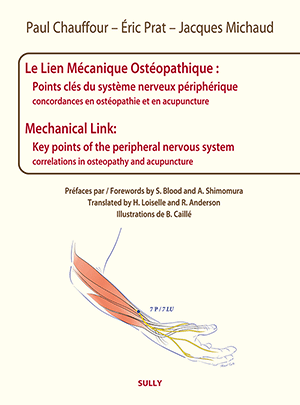Mechanical Link: key points of the peripheral nervous system
Bilingual edition English / French
Paul Chauffour et Eric Prat et Jacques Michaud
The nervous system, directing and managing all body functions, was always an important topic of observation for Andrew Taylor Still, founder of osteopathy.
Nombre de pages : 304
Format : 200 x 270
Date de parution : mars 2017
ISBN : 978-2-35432-213-7
English version translated by H. Loiselle and R. Anderson
Illustrations by Benoit Caillé
en stock
Collection : OstéopathieNombre de pages : 304
Format : 200 x 270
Date de parution : mars 2017
ISBN : 978-2-35432-213-7
62,00€
English version translated by H. Loiselle and R. Anderson
Illustrations by Benoit Caillé
The authors are French osteopaths who are world renowned for the quality of their teaching, and in this book they present an entirely novel approach of the peripheral nervous system based on a rapid and precise diagnosis of the critical points to be treated.
The book exposes in an educational manner the etiology of osteopathic nerve lesions and their correlation with major points of acupuncture, and gives detailed descriptions of each of the principal key points of the peripheral nervous system as well as their clinical correlations with a number of functional pathologies, that may or may not be symptomatic.
The quality of the artwork, which includes over 200 original illustrations–drawings, dissections and photographs by the authors–clearly displays the anatomy of nerves as well as the best way to approach the neural point. An entire chapter has been devoted to the encephalon and the new osteopathic treatment perspectives in this field, completing this book as a reference on the manual approach to the nervous system.
This book is intended for all osteopaths and health professionals who wish to broaden their horizons by integrating in a simple but efficient way the evaluation and treatment of “the neurological link” into their practice.
Foreword, Akiyoshi Shimomura
Introduction
• Mechanical Link
Concept of total lesion
Concept of primary lesion
Concept of specific treatment
• Anatomical-physiological organization of the nerve
and osteopathic considerations
Embryology
Sensory cutaneous organization
Motor muscular organization
Autonomic nervous organization
Histology and physiology
Structure of the peripheral nerve
Neurological safety
Anatomical safety
Biomechanical safety
Resistance to compression
Resistance to elongation
Resistance to friction
Osteopathic lesion of the nerve
Types of nerve lesions
Etiology of nerve injury
• Key points of the nervous system
List of the key points of the nervous system
Points of compression
Points of convergence
Points of exposure
Points of emergence
Distal points
Neural points and corresponding points of acupuncture
Osteopathy and acupuncture
Peripheral nerves and acupuncture meridians
Neural key points and acupuncture points
Nerve impulse and energy circulation
Clinical considerations
• Osteopathic practice
Location of the neural key point
Tension test of the neural key point
Inhibitory balance test of the neural key point
Treatment of the neural key point with the recoil
• Anatomical review
Cranial nerves
Trigeminal nerve
Facial nerve
Vagus nerve
Accessory nerve
Cervical nerves
Greater occipital nerve
Nerves of the superficial cervical plexus
Phrenic nerve
Brachial plexus
Suprascapular nerve
Nerves of the upper extremity
Radial nerve
Musculocutaneous nerve
Median nerve
Ulnar nerve
Nerves of the lumbar plexus
Collateral branches of the lumbar plexus
Femoral nerve
Obturator nerve
Sciatic nerve
Filum terminale
Siatic nerve
Tibial nerve
Fibular nerve
Sural nerve
• Test descriptions
Cranial nerves
Supratrochlear nerve
Supraorbital nerve
External nasal nerve
Infraorbital nerve
Mandibular nerve
Mental nerve
Facial nerve
Vagus nerve (1)
Vagus nerve (2)
Accessory nerve
Cervical nerves
Greater occipital nerve
Posterior branches of the cervical nerves
Punctum nervosum
Lesser occipital nerve
Great auricular nerve
Phrenic nerve
Suprascapular nerve
Trunks of the brachial plexus
Cords of the brachial plexus
Branches of the brachial plexus
Upper extremity nerves
Radial nerve
Radial nerve bifurcation
Posterior interosseous nerve
Superficial branch of the radial nerve
Dorsal digital nerves of the radial nerve
Lateral antebrachial cutaneous nerve
Median nerve (1)
Median nerve (2)
Ulnar nerve (1)
Ulnar nerve (2)
Lumbar plexus nerves
Lumbar plexus
Iliohypogastric nerve
Ilioinguinal nerve
Lateral femoral cutaneous nerve
Obturator nerve
Femoral nerve
Saphenous nerve (1)
Saphenous nerve (2)
Saphenous nerve (3)
Saphenous nerve (4)
Sciatic nerve
Tibial nerve (1)
Common fibular nerve
Deep fibular nerve (1)
Deep fibular nerve (2)
Deep fibular nerve (3)
Superficial fibular nerve
Sural nerve
Lateral dorsal cutaneous nerve of the foot
Tibial nerve (2)
Plantar digital nerves
Intercostal nerves and lumbosacral nerves
Intervertebral disc herniation
Filum terminale
Nerves of the gluteal region
Intercostal nerves
The encephalon
Anatomical organization of the encephalon
Osteopathic lesions of the encephalon
Osteopathic approach of the encephalon
Osteopathic treatment of the encephalon
A few clinical cases
Cerebral hemispheres
Corpus callosum
Diencephalon
Limbic system
Brainstem
Cerebellum
Conclusion
Bibliography

